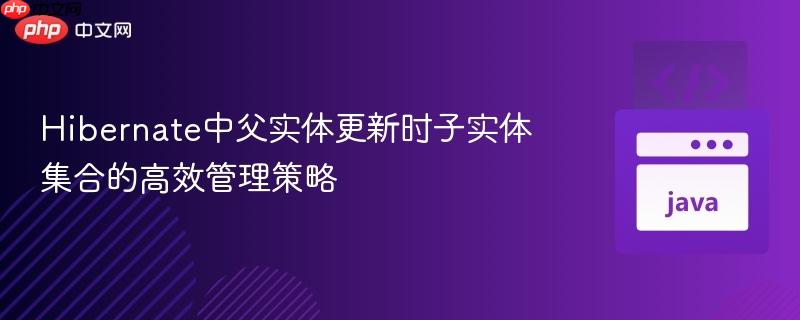
本教程详细阐述了在Hibernate中更新父实体时,如何高效且正确地管理其关联的子实体集合。核心策略是利用Hibernate的级联操作和`orphanRemoval`特性,通过先清空现有子集合,再添加新子实体的方式,实现自动的增删改,避免手动管理复杂的状态同步,确保数据一致性。
在基于Java的持久化应用中,使用Hibernate管理实体关系是常见的场景。当处理父子实体关系,特别是父实体包含一个子实体集合(如Recipe包含RecipeIngredient)时,更新父实体往往涉及到子集合的增、删、改操作。手动管理这些变化可能变得复杂且容易出错。本教程将深入探讨在Hibernate中处理此类更新的推荐策略。
假设我们有一个Recipe实体,它通过一个中间表RecipeIngredient关联了多个Ingredient。RecipeIngredient实体作为Recipe的子实体,可能包含数量等额外信息。当我们更新一个Recipe时,其关联的RecipeIngredient集合可能会发生变化:
例如,一个Recipe最初有IngA, IngB, IngC三种配料。更新后,可能变为IngA, IngX, IngY。这意味着IngB和IngC被移除,而IngX和IngY被添加。如何让Hibernate自动处理这些变化,而不是手动编写删除、插入逻辑,是我们需要解决的核心问题。
Hibernate提供了一种简洁高效的解决方案:在更新父实体时,首先清空其现有的子实体集合,然后将请求中所有新的子实体添加到该集合中。结合正确的JPA/Hibernate映射配置,Hibernate将自动处理底层数据库的增删操作。
要使这种“清空并重建”的策略生效,父实体与子实体集合的映射必须配置cascade = CascadeType.ALL和orphanRemoval = true。
以Recipe和RecipeIngredient为例,Recipe实体中的recipeIngredients集合应如下配置:
// Recipe.java
@Entity
public class Recipe {
@Id
@GeneratedValue(strategy = GenerationType.IDENTITY)
private Long id;
private String title;
// 关键配置:cascade = CascadeType.ALL 和 orphanRemoval = true
@OneToMany(mappedBy = "recipe", cascade = CascadeType.ALL, orphanRemoval = true)
private Set<RecipeIngredient> recipeIngredients = new HashSet<>();
// 构造函数、Getter、Setter 等
// ...
// 辅助方法,用于在双向关联中保持一致性
public void addRecipeIngredient(RecipeIngredient recipeIngredient) {
recipeIngredients.add(recipeIngredient);
recipeIngredient.setRecipe(this);
}
public void removeRecipeIngredient(RecipeIngredient recipeIngredient) {
recipeIngredients.remove(recipeIngredient);
recipeIngredient.setRecipe(null);
}
}
// RecipeIngredient.java
@Entity
public class RecipeIngredient {
@Id
@GeneratedValue(strategy = GenerationType.IDENTITY)
private Long id;
@ManyToOne(fetch = FetchType.LAZY)
@JoinColumn(name = "recipe_id")
private Recipe recipe;
@ManyToOne(fetch = FetchType.LAZY)
@JoinColumn(name = "ingredient_id")
private Ingredient ingredient;
private Double quantity; // 假设 RecipeIngredient 有额外属性
// 构造函数、Getter、Setter 等
// ...
public RecipeIngredient(Recipe recipe, Ingredient ingredient) {
this.recipe = recipe;
this.ingredient = ingredient;
}
}
// Ingredient.java (通常是一个独立的查找实体)
@Entity
public class Ingredient {
@Id
@GeneratedValue(strategy = GenerationType.IDENTITY)
private Long id;
private String name;
// ...
}有了正确的映射配置,更新逻辑变得非常简洁。以下是基于原始问题的update方法的改进版本:
import org.springframework.stereotype.Service;
import org.springframework.transaction.annotation.Transactional;
@Service
public class RecipeService {
private final RecipeRepository recipeRepository;
private final IngredientRepository ingredientRepository;
public RecipeService(RecipeRepository recipeRepository, IngredientRepository ingredientRepository) {
this.recipeRepository = recipeRepository;
this.ingredientRepository = ingredientRepository;
}
@Transactional // 确保整个操作在一个事务中
public void updateRecipe(RecipeRequest request) {
// 1. 加载现有的 Recipe 实体
final Recipe recipe = recipeRepository.findById(request.getId())
.orElseThrow(() -> new NoSuchElementFoundException("Recipe not found with ID: " + request.getId()));
// 2. 更新 Recipe 的基本属性
recipe.setTitle(capitalizeFully(request.getTitle())); // 假设 capitalizeFully 是一个辅助方法
// 3. 核心步骤:清空现有子集合
// 注意:这里直接操作集合,Hibernate会追踪这些变化
recipe.getRecipeIngredients().clear();
// 如果 RecipeIngredient 有双向关联,并且 RecipeIngredient.setRecipe() 不为 null,
// 则在 clear 之前可能需要手动将每个被移除的 RecipeIngredient 的 recipe 字段设为 null,
// 以避免在某些情况下出现意外行为,但 orphanRemoval=true 通常会处理好。
// 对于本例,由于是新建 RecipeIngredient,所以无需在 clear 之前操作 setRecipe(null)。
// 4. 根据请求添加新的 RecipeIngredient 实例
request.getRecipeIngredients().forEach(recipeIngredientRequest -> {
// 获取或创建 Ingredient 实体
final Ingredient ingredient = ingredientRepository.findById(recipeIngredientRequest.getIngredientId())
.orElseThrow(() -> new NoSuchElementFoundException("Ingredient not found with ID: " + recipeIngredientRequest.getIngredientId()));
// 创建新的 RecipeIngredient 实例,并关联到当前 Recipe 和 Ingredient
RecipeIngredient newRecipeIngredient = new RecipeIngredient(recipe, ingredient);
newRecipeIngredient.setQuantity(recipeIngredientRequest.getQuantity()); // 假设请求中包含数量
// 将新的 RecipeIngredient 添加到 Recipe 的集合中
recipe.addRecipeIngredient(newRecipeIngredient); // 使用辅助方法保持双向关联一致性
});
// 5. 保存 Recipe 实体。由于 Recipe 是受管理的实体,调用 save() 并非严格必要,
// 但显式调用可以确保所有更改被刷新到数据库,且在某些场景下更清晰。
// 如果方法是 @Transactional,Hibernate会在事务提交时自动同步所有变更。
recipeRepository.save(recipe);
}
// 假设的辅助方法
private String capitalizeFully(String text) {
return text != null ? text.substring(0, 1).toUpperCase() + text.substring(1).toLowerCase() : null;
}
}在Hibernate中更新父实体并管理其子实体集合时,最推荐且高效的方法是利用@OneToMany映射上的cascade = CascadeType.ALL和orphanRemoval = true配置。通过加载父实体,清空其现有子集合,然后将新的子实体添加到集合中,Hibernate将自动处理所有必要的数据库操作(插入、删除),极大地简化了开发工作,并确保了数据的一致性。这种策略在提供代码简洁性的同时,也充分利用了Hibernate的强大功能。
以上就是Hibernate中父实体更新时子实体集合的高效管理策略的详细内容,更多请关注php中文网其它相关文章!

每个人都需要一台速度更快、更稳定的 PC。随着时间的推移,垃圾文件、旧注册表数据和不必要的后台进程会占用资源并降低性能。幸运的是,许多工具可以让 Windows 保持平稳运行。

Copyright 2014-2025 https://www.php.cn/ All Rights Reserved | php.cn | 湘ICP备2023035733号